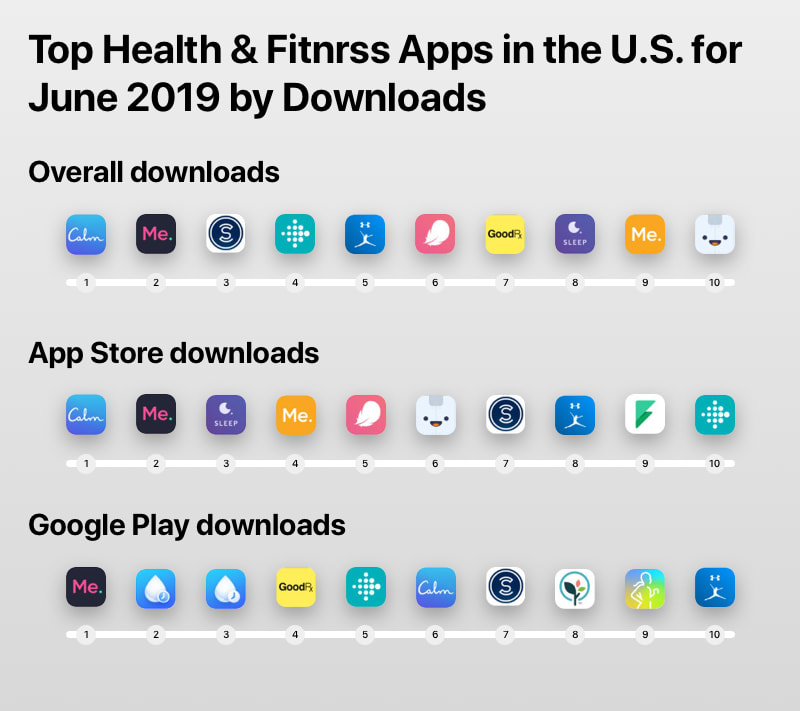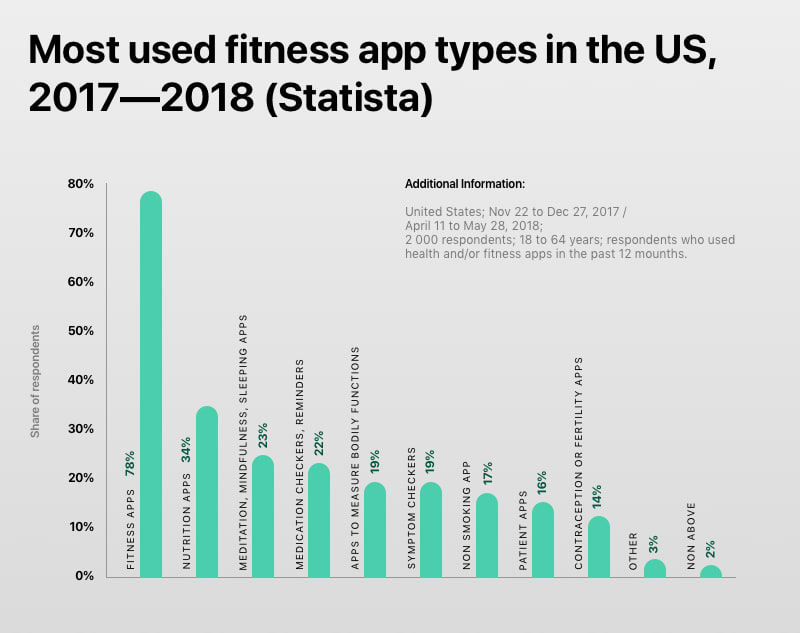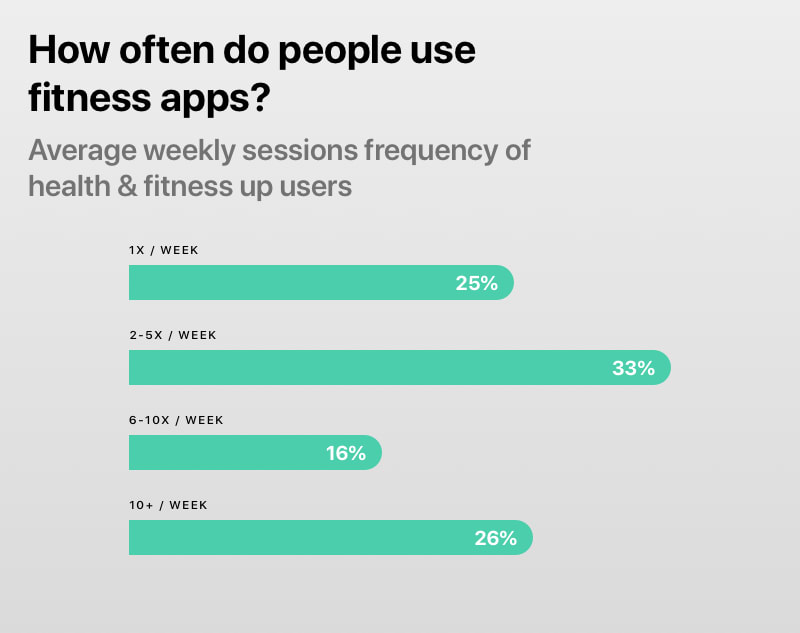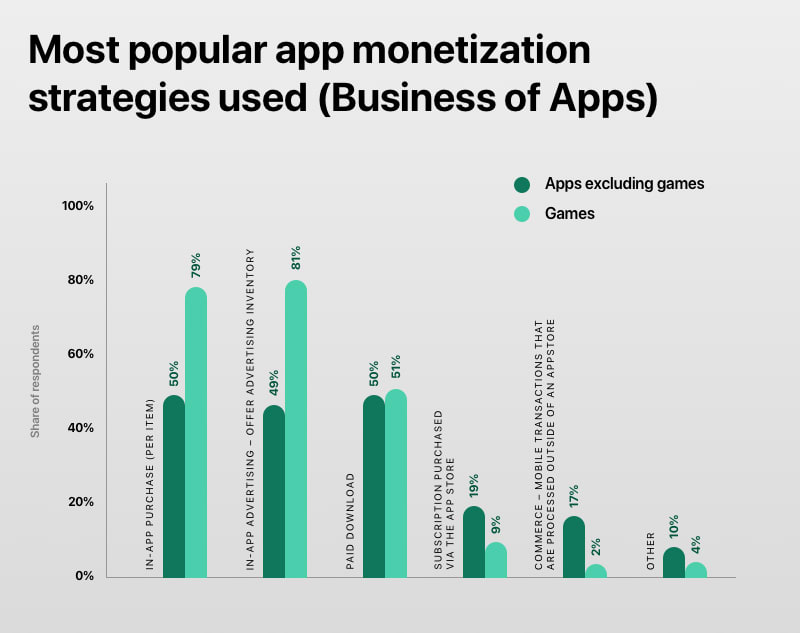Fitness digital products segment remains extremely demanded within the decade. In 2019, its revenue is expected to reach $16,857 million, and the CAGR (Compound annual growth rate) of 2019—2023 is estimated at 5%.
Custom workout apps, as well as activity trackers, got an impetus for development due to IoT tech achievements, a surge in interest in AI, and some social changes.
Today’s average megapolis citizen doesn’t have time for gyms but tends to keep fit without breaking their work schedule or travel plan.
That is also common for sport and food products brands to create a fitness app and gain extra loyalty from customers.
It doesn’t matter if you are a person with another fitness app idea or a brand owner who plans to strengthen relations with a target audience, the article will help you to find your fitness app niche and estimate the idea.
Fitness App Types
So what is a fitness app? In 2017, up to 75% of users admit checking their fitness app twice a week or more often. At the same time, each fourth mobile user follows fitness app instructions more than 10 times per week. Today, the statistics look even more appealing, but what’s the hint?
Fitness apps are focused on vital signs monitoring, prevention of diseases, as well as improving the physical shape of their users. In medical terms, most of them are personal healthcare tools that replace basic physiotherapists, nutritionists, personal trainers, yoga teachers and consultants on a healthy lifestyle help.
Create your own workout app in one of the most demanded fields:
Workout apps
examples — MapMyFitness, Sworkit, Tone It Up, Daily Burn, Tabata HIIT Interval Timer
Workout apps are products that help people train outside of the gym. The idea is to help users lose weight or build muscles. There, you could find sets of exercises for short yet intensive workouts (up to 10 minutes).
Exercises torch calories during a short period of time and become harder and more complicated from day to day. Apps should be used regularly to provide user with a discreet result.
Running apps are also a kind of workout product. Although they don’t usually have a set of exercises users have to follow, they track running or cycling activities using GPS, calculate burned calories and suggest distances for next trips.
Yoga apps
examples — Daily Yoga, Pocket Yoga, 5 Minute Yoga, Down Dog
Yoga apps have much in common with workout products. They allow you to set fitness goals and enter the virtual yoga class where you’ll find instructions on yoga-based exercises. Users can practice at home, in the park, or even in transport. The idea is to develop body flexibility, strengthen immunity, or just relax
Activity tracker app
examples — Google Fit, Runkeeper, Runtastic Running Distance & Fitness Tracker
Most of the virtual workout apps have activity tracking features. However, to gain data they need wearable devices connectivity (with fitness bracelets, smartwatches or other more specific health tracking tools — glucometers and blood pressure trackers).
Some tracking apps are dedicated to particular sport such as cycling, running, climbing, or swimming. Apps allow users to share their progress with friends on social media.
Meditation app
examples — Mindfulness App, Headspace, Calm
Meditation apps are not about sports, but about maintaining the psycho-emotional health of users. Apps remind you to switch your mind, calm down and breath deeply. As one needs to repeat meditation sessions every several hours, apps usually have a high retention score.
Nutrition app
examples — HealthyOut, Calorie Counter & Food Diary, Food Intolerances, Waterlogged
Water drinking, nutrition, and diet apps help users eat or drink regularly, consume a proper number of calories, and reach their fitness goals.
A person could use an app of this kind to gain or lose kilos, or to improve health by balancing nutrition. Apps can remind users if it’s time to eat, create shopping lists, and track daily activities.
How to create a fitness app? Choose the segment properly! Keep in mind that most of the fitness apps combine several functions. For example, the Runtastic Running app has activity tracking mode and Daily Yoga is also a meditation app.
How to Make a Fitness App step by step
Fitness app development is similar to any other mobile app development. In LANARS previous blog article (How to Develop an App) you may find detailed information on how to start the discovery stage, estimate your budget, and find perfect executors for your idea implementation.
Here, we’d like to focus on key aspects of fitness app development. Follow those steps having an app idea in your mind:
Step 1. Select your fitness app type
In the paragraph above you could check the full list of them. Consider that apps could be hybrid! Compare your app idea with existing app types and think of the market segment you are going to interfere with your product.
Step 2. Discover your competitors and target audience
The fitness app segment is extremely competitive. To hit niche leaders you need to know their weak points as well as their products’ advantages. Study your target audience to understand who’s also fighting for the audience’s attention and wallet. List what could persuade your audience to choose your product.
Step 3. Pick MVP features
How to make a fitness app? Think of your idea as a product and list its basic features. To learn more about MVP (minimum viable product) development read our article called How to Build an MVP. Keep in mind that MVP needs to be a ready-to-use product that carries a major market advantage of your idea.
Step 4. Find dedicated developers team and workout an app
...Or choose in-house development if you have a digital department inside your company. In other cases we recommend you to work with a reliable remote team. Use our article How to Hire a Dedicated Development Team to avoid money loss.
On that stage, you’ll also have to set a budget and monitor the development process. Depending on development concept (in-house or remote, freelancers hiring or team outsourcing) your approach may vary.
Step 5. Launch your product and study user feedback
Update your app having real users experience at your hand. Check if your monetization strategy works and improve it if not. Plan the next marketing campaigns and conduct them.
Note! How to make a fitness app? Promotion strategy is also part of the development process. Develop it on the very first stage of your project idea implementation — choose your monetization strategy, plan your incomes and marketing outcomes, and be ready to start promoting your product several weeks before product release.
Make Your Own Workout App: Key Features
Sure, app feature sets differ according to fitness apps’ topics and business goals. In this article, we’ve decided to focus on those features that are similar to any sport, health monitoring, or nutrition app MVP. Extra features may be based on listed ones.
User signup and logging in
Fitness apps work only with personal accounts. Users should have a tool to edit their profile, set fitness goals, enter health metrics, and add training or nutrition suggestions. A personal profile may also include a photo. The access to profiles should be provided via a social network profile, phone number, or email.
Community building
The reason why fitness apps are so popular is humans’ desire to be appreciated by others. That is also important for many to obtain other people’s support. Give users a chance to exchange their fitness results, ask others for advice, or just follow somebody’s nutrition example. Things are getting easier when you are not alone!
Third-party devices connectivity for user activity tracking
Fit trackers, smartwatches and other wearable devices, personal medical equipment for vital signs monitoring, and mobile GPS trackers should send data to your app. That will help you provide users with personal fitness advice and track their results precisely. You can also create your own workout app (Android or iOS) using Google Fit and Apple HealthKit integration.
Notifications
Nutrition and meditation apps should send users reminders when it’s time for eating or relaxing, and fitness apps could let them know when their sports goal is reached.
Exercises, meal plans, or something else
We don’t know what kind of app you are going to build, but in any case, you’ll need a suggested activity section inside your app. This is a place where you could put instructions on exercising or cooking, advises on daily activities or mindset. Update information regularly. Make this section convenient for users. Who knows, maybe a good idea is to present exercises as an interactive to-do-list or something.
Reports
How to make a fitness app that will be strongly demanded? Users download fitness apps as they believe that they could become stronger, healthier, and slimmer, or develop their emotional state with them. Make their progress visible to motivate them to proceed!
Payments
If you choose the freemium monetization model or you plan to support in-app purchases, make sure you know the way users can send you money. Integrate e-commerce elements to your product.
Create a Fitness App: Choose Your Platform
Choosing a platform is a critical stage of any app development process. If you’d like to know all the advantages and disadvantages of iOS, Android as well as a cross-platform development approach, read our recent article.
In this paragraph, we’ll help you make your own workout app considering key advantages of two major platforms and regarding fitness app segment peculiarities. Mind that there are 5 factors that may influence your final decision — target audience, deadlines, app features, design complexity, and the revenue plan.
Why Android?
The Android market is wider than iOS. Most people in the world use it. Android is the dominant OS in up-and-coming markets — in Africa, Latin America, and Asia. If your app is targeted on men, you should also give your preference to Android (most men use it).
Building your own workout app for Android means extra flexibility. Apple’s official language Swift is high-standardized, while Android resembles an open-source that is easy to customize.
Why iOS?
iOS device users spend much money on in-app purchases and generally are more likely to pay for your app. At the same time, iOS native development is cheap as there are not so many types of Apple mobile devices currently released.
The approach works well if you plan to hit Western Europe, Australia, and North America market. There, iOS is dominant.
Women are more likely to choose iOS than Android too. Consider this, analyze your app targeting. iOS users are also younger — people from 18 to 24 years old are more likely to prefer Apple mobile devices.
Most of iOS users obtain an academical degree (University diploma).
Note! Cross-platform development is one more idea you could follow if you are not sure about your target audience. With a single codebase, the cross-platform app can work on Android and iOS devices. With a certain design effort, they will look as beautiful as native ones!
Non-Development Challenges
Сustom workout app development requires not only financial resources but also a bit of management creativity. The fitness app segment is a highly competitive environment. To hit the competitors you need to differ from them completely providing users with new solutions for their everyday fitness tasks or outstanding product quality.
To prepare you for the development process, we collected some typical issues that do not belong to the tech field:
Advertisement
Promotion is critical for your upcoming fitness app. Your target audience seems to have been already captured by one of your competitors. How do you plan to reach it? Analyze their promotion campaigns and find the answer. A good idea is to try to attract those who had no experience with competitors’ products or do not use any fitness product yet.
Updates
Create a fitness app is not an easy task as there are lots of apps coming to the market every day. If you’ve launched your product successfully they may want to follow your example or just copy your product. To keep your audience you need to generate updates, improve your product, and stay up-to-day. For this, you need a development plan!
Experts
You’ll hardly imagine a professional gym without a couch or a physiotherapist. Same works for a fitness app. If you plan to create your own workout app as a truly useful product, you need a medical expert, experienced nutritionist, and sports couches in your team. Try to get their advice at the stage of approving the startup idea.
Medical issues
Sometimes, a fitness app does harm to its users. Diet apps, online stretching courses, and running apps are of that risky kind. Remember, that to execute sports tasks suggested by your app, people need to have a certain level of body development. Provide users with different types of activities and warn them about the dangers of some actions.
How Fitness App Developers Make Money: Monetization
In 2018, the fitness app market was estimated at USD 2.27 billion. Most of the apps presented there were commercial.
Naturally, your fitness app design and features could be a great source of income. The question is how to choose the best way to monetize your product. In our article How to Monetize Your App Idea, you will find detailed information on all monetization strategies used in the modern world.
Here, we would like to describe 4 commercial models that are easy to implement if your product is a fitness app.
Paid applications
The easiest way to get money out of your idea is to sell it to direct users. You’ll also have fewer competitors among paid apps (less than 1% of apps are paid). However, you need to be sure that your product is valuable and understandable enough for users to pay for it. Start with giving them access to a trial.
Freemium and Premium
Create a free version of your app (with limited features and adds), and then suggest users purchasing a Premium version or Premium subscription plan. Most fitness apps use this monetization model.
In-app advertisement
Your app could be completely free to download! Sell space inside your app to one of the mobile ad networks and get money for each ad view. In-app advertisement can take various forms — banners, rewarded videos, or animated pop-ups.
In-app purchases
Building a fitness app for getting the revenue out of its users directly is not always an issue. Brands like Nike, Adidas, or Reebok launch their apps as an instrument to raise brand awareness and loyalty. However, some of them may integrate shopping mode to the app.
Using a self-standing fitness application, you could also sell smartwatches and other wearable devices.
How Much Does It Cost to Create a Fitness App?
How to create a fitness app? As you may presume, the final bill for fitness app development could vary. Regarding your tech and design requirements, a form of cooperation with your team, country of hiring your experts, chosen platforms and programming languages, project deadlines, and other factors your budget could be $15 000 or $50 000. And you still need some money for promotion.
In our previous article How Much Does It Cost to Make an App you’ll find details on app development budgeting and hints on how to avoid unreasonable spendings. There, you could find key expenditures and hour estimation for them.
- Discovery stage, experts consulting, and design prototyping — from 40 hours
- UI and UX Design — 50—90 hours
- Content generation — 30 hours
- iOS, Android, or cross-platform development — from 200 hours
- Back-end development — 400 hours
- Quality testing — 100 hours
- Product polishing — 40 hours
Take into consideration that your app should be updated after the MVP release. Put at least 10% of your basic budget into this task. According to your app idea, you may also need administrators, content managers, and support managers in your team.
If you create your own workout app for Android be ready to spend up to 20% more on tech issues. Cross-platform development is even more expensive.
The average hourly rate for those types of work on Eastern Europe markets (and in LANARS company in particular) is $50 per hour. Eastern Europe is considered to be an option for those who’d like to get high-quality results for less money (compared to the USA, Germany, the UK, or Sweden).
Conclusion
Make your own workout app! The fitness app market is continuing to grow and its revenue is predicted to cross the line of $30 million by the end of 2020. Last year, there were more than 250,000 healthcare, fitness and yoga apps available in Google Play Market and App Store. But is there any place for a newcomer, you may wonder. Sure! — we say.
2019 is much more different from the previous years of the decade. IoT and AI came to our daily lives to help with routine tasks, eHealth approach is now used in most medical institutions of the world, and wearable or portable fitness devices has finally become mass products. All this made a potential number of fitness app users bigger.
In addition, Apple HealthKit and Google Fit updates releases become an incentive for the implementation of creative fitness ideas of startups. And you can be one of those who invent a new way to use fitness hardware, why not? Good luck to you then!







Top comments (8)
This is a very helpful article. Thank you for giving such useful information on Fitness App Development and advanced features, as well as tips on how to achieve. and also refer about flicknexs platform
Explore this helpful article on Fitness App Design Templates! Whether you're a fitness app developer or designer seeking inspiration, this resource provides valuable insights into using design templates effectively. Discover a range of pre-designed templates tailored for fitness apps, including workout trackers, meal planners, and progress dashboards. Streamline your design process and create stunning fitness apps with ease. Don't miss out—check out the article now: Fitness App Design Templates
Great guide! You’ve broken down the process so clearly, making it easy to understand all the steps involved. Partnering with a fitness app development company really seems like the best way to ensure success, especially for businesses starting from scratch. This post is super helpful for anyone looking to get started with their own fitness app!
The solution of app development in fitness can address the major concern of your target audience who can put exercising as a routine helping them to better their fitness and health.
Today, the conditioned working atmosphere has changed a lot of things, everything is channelized & efficiency of work is heightened. But, we tend to forget that our lifestyle has been compromised, due to which health is being overlooked. You can now leverage this aspect and create a fitness app and be a supplement for change that you wish to see and flourish in this streaming business.
Very helpful article. Thanks for sharing the great information on Fitness App Development and advance features and how to get succeeded.
Some comments may only be visible to logged-in visitors. Sign in to view all comments.